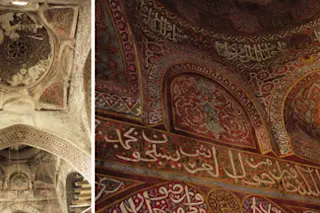In the highlands of southern Yemen lies Rada, a dusty, remote town in one of the world's poorest countries. It was not always so. In 1503 Italian explorer Lodovico de Varthema described it as "beautiful and ancient, populous and rich." Its most prominent surviving landmark dates from that time: a grand mosque and palace, constructed by Sultan Amir ibn Abd al-Wahhab. In its prime, the building was a massive, filigreed, colorful monument to Islam, a flamboyant display of wealth born of trade with India. The sultan was so delighted with his project that he ordered lamps lighted in all the windows so that he and his daughter could ride the surrounding hills in the evening and enjoy his glowing creation.
Five centuries later, it lay bulletriddled, trash-strewn, and in ruins. The exterior, constructed of limestone and baked brick, had crumbled. The prayer hall's murals were covered in generations of whitewash. ...















